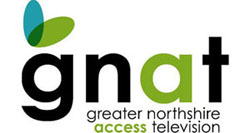Community Media in a Time of Change – Notes From the Conference
Traditional news media outlets are failing to keep pace with the radical transformations underway in America.
Public access media has a role and a responsibility to step up and help fill this void.
That was a major part of the message delivered by John Nichols, the keynote speaker at the start of the the three-day Alliance for Community Media we’re attending here in Boston this week. Tammie Reilly, Hoss Wuerslin and I are here to learn more about how to up our game even more at GNAT-TV and do our part to fill that void.
Nichols is the national affairs correspondent with The Nation Magazine and the associate editor of the Capitol Times of Madison, Wisc. He gave an impassioned speech to the sizable audience assembled here for the conference about the role of public access media during a time of radical change, touching on globalization, digital evolution, and — looking ahead into the near future — robotification (when cars drive themselves and we don’t need as many truck drivers, and bank ATMs do replace traditional bank tellers, and automation of work eliminates time honored jobs of all description).
These are jarring transformations and haven’t been well-managed so far, he said, while noting the richness and possibilities inherent in all this change.
But it all makes folks uneasy. Witness the 2016 presidential election.
Into this vortex public access media needs to step, he argued, noting the now-familiar decline of many local and middle market news outlets and the concentration of media at the upper levels. At the same time, we’re seeing the profusion of social media entering the picture, but much of that is unvetted opinion ranting thinly disguised as news or information, reliable or not. Hyper- local coverage of communities in particular needs reinforcement, to rebuild the bridge between citizens and their local institutions, governmental or otherwise.
Quick test — how many school board or select board members do you know — or could even name — in your town? Probably not many. Don’t feel bad — you’re not the only ones. But that’s not as it should be.
It was an inspiring kick-off to the conference, which continued Friday morning with a round of workshops designed to help us build or strengthen that bridge. Hoss and I went to one on community engagement strategies for community media, which seemed a good follow up from Nichol’s speech. The 90 minute session broke down into four larger groups after opiate addiction, affordable housing, police relations with African-Americans and education issues were identified as areas which all seemed to be playing large roles to the nearly 100 people crammed into the meeting room. I sat in on the opiate addiction group, since that’s perceived as such a large problem in Vermont, and our corner of the state is hardly exempt. What’s interesting is that not only are so many communities grappling with it, but how some places are doing way more than others. It shows what enlightened and sensitive leadership can do, or avoid doing in the absence of spark plug type leadership. The now-familiar questions and “where do we go from here?” are comparable. Some seemed to be way ahead of us in terms of launching community forums and engagement to develop concrete solutions or first steps. De-stigmatizing the question, noting that many ordinary people who never imagined themselves growing up to be addicted to opioids had found themselves in this place, was one. What’s the proper role of law enforcement? Where is the responsibility of the medical community and “Big Pharma?”
And how do we report on this, tell the stories and shine a light?
Even though heroin addiction and its related issues of crime and treatment options burst onto the local scene relatively recently, already you see the eye glazing response when the topic comes up. It’s not one that seems to inspire a straightforward, obvious solution. But it’s not hopeless. It can’t be hopeless. We have to figure out a way to drill down and unpackaged it into absorbable pieces to assist in the turnaround.
More to come! We’ve only just started. This afternoon it’s on to digital equity and emergency response. And then the real challenge — applying all of this to the real-world of reporting the news and engaging the public in it in our 11 town service area.


